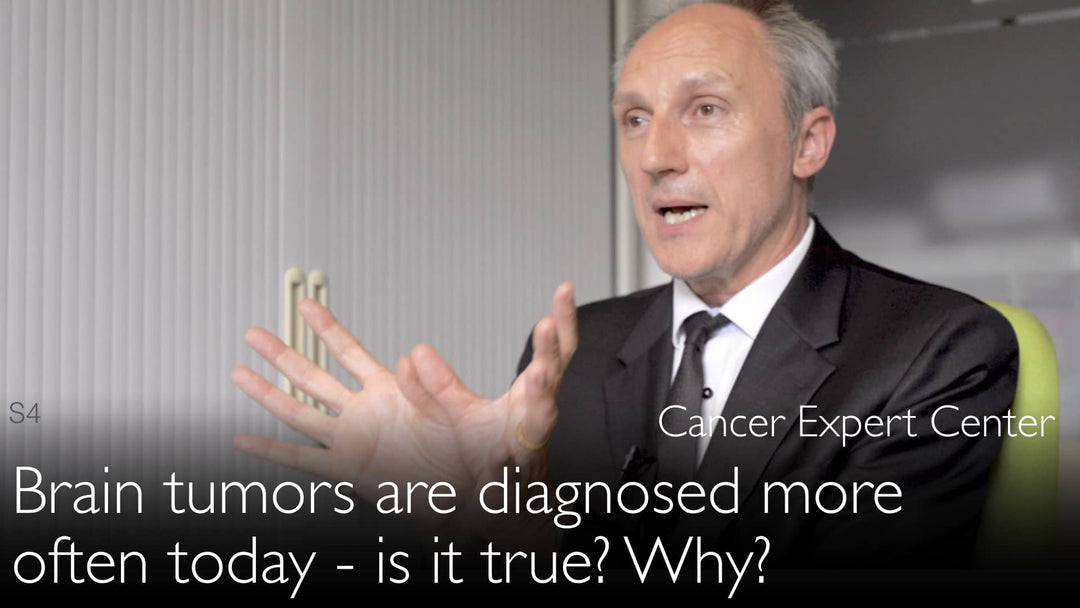Leading neuropathology expert Dr. Sebastian Brandner, MD, examines why brain tumor diagnoses have risen approximately 25% over the past 25 years, exploring whether this reflects true increased incidence or improved diagnostic detection through advanced imaging technologies like MRI and CT scans.
Brain Tumor Diagnosis Rates: Understanding the 25% Increase in Detection
Jump To Section
- Rising Brain Tumor Diagnosis Rates
- Survival Challenges in Brain Cancer
- The Age Factor in Tumor Detection
- Diagnostic Imaging Advances
- Detection Bias Considerations
- Future Research Directions
- Full Transcript
Rising Brain Tumor Diagnosis Rates
Statistics indicate approximately 25% more brain tumors are diagnosed today compared to 25 years ago, though Dr. Sebastian Brandner, MD, notes variations exist between data sources. The neuropathology expert emphasizes this trend requires careful interpretation, particularly regarding whether figures are age-adjusted. Dr. Sebastian Brandner, MD, explains that while the numbers suggest increased incidence, multiple factors beyond actual disease prevalence could contribute to this statistical rise.
Survival Challenges in Brain Cancer
Brain tumors remain among the most challenging cancers, with Dr. Sebastian Brandner, MD, highlighting their persistently lower long-term survival rates compared to other malignancies. While many cancers have seen significant survival improvements in recent decades, brain tumor outcomes have progressed more slowly. This context makes accurate incidence data particularly important for research allocation and therapeutic development.
The Age Factor in Tumor Detection
Dr. Brandner proposes aging populations as one potential factor in increased brain tumor diagnoses. "30-40 years ago, patients didn't reach the ages where we now see many individuals remaining healthy enough to develop symptomatic tumors," explains the neuropathology expert. Older patients experiencing seizures or neurological symptoms now more frequently receive imaging that may detect previously undiagnosed tumors.
Diagnostic Imaging Advances
The introduction and widespread adoption of MRI technology in the early 1990s revolutionized brain tumor detection, as Dr. Sebastian Brandner, MD, notes. "The threshold for ordering CT or MRI scans has decreased significantly," he observes, with seizures now routinely prompting advanced imaging. This diagnostic sensitivity means tumors that might have gone undetected in previous decades are now being identified, potentially inflating incidence statistics without representing true disease increase.
Detection Bias Considerations
Dr. Brandner cautions that apparent increases in brain tumor rates may reflect detection bias rather than actual epidemiological change. "Without age-adjusted statistics and accounting for diagnostic methodology changes, we can't conclude there's a true incidence rise," Dr. Sebastian Brandner, MD, explains. He emphasizes the need for studies controlling for these variables before drawing definitive conclusions about changing brain tumor patterns.
Future Research Directions
Dr. Sebastian Brandner, MD, calls for rigorous analysis of brain tumor epidemiology using standardized, methodology-controlled data. Future research should clarify whether diagnostic advances or true biological factors drive observed increases. As Dr. Sebastian Brandner, MD, notes to Dr. Anton Titov, MD, "Understanding these patterns is crucial for allocating research resources and improving outcomes for brain tumor patients."
Full Transcript
Dr. Anton Titov, MD: Incidence of brain tumors is rising. Over the last 20 years, about 25% more brain tumors are diagnosed than were diagnosed 25 years ago. Statistics vary depending on sources.
Dr. Anton Titov, MD: What could be the reason for the increase in the rate of brain tumors?
Dr. Sebastian Brandner, MD: It's also important to highlight this. Brain tumors remain quite challenging in cancer care. Relatively fewer patients survive brain tumors. Brain tumors have lower long-term survival compared with many other cancers. Other cancers have seen significant progress in survival rates recently.
Dr. Sebastian Brandner, MD: I haven't seen those specific statistics. First, it would be important to see whether the data is corrected for age. 30-40 years ago, patients didn't reach the age at which many now remain in good health. They could become symptomatic with a seizure, go to the doctor, and receive imaging.
Dr. Sebastian Brandner, MD: The threshold for CT or MRI scans has decreased significantly. Performing an MRI after a seizure is now very common. The likelihood of discovering a brain tumor is probably higher now.
Dr. Sebastian Brandner, MD: Without having seen the statistics, I cannot confirm whether they were age-adjusted or what exactly they show. I would be surprised if brain cancer incidence has actually increased. The data should be corrected for detection limitations.
Dr. Sebastian Brandner, MD: My initial thought would be that detection methods changed in the 1970s-1980s. The likelihood of undergoing CT or MRI scans has increased. MRI scans were only introduced in the early 1990s. This could contribute to higher brain tumor detection rates, thereby increasing the reported incidence.
Dr. Sebastian Brandner, MD: We probably have better diagnostics for brain tumors now. That would be my guess.
Dr. Anton Titov, MD: I have not seen the statistics you quoted here.
Dr. Sebastian Brandner, MD: I better not comment on the reasons for the increase in brain tumor occurrence.
Brain tumors are diagnosed about 25% more today compared with 25 years ago. What could explain this rise in brain tumor diagnoses?




